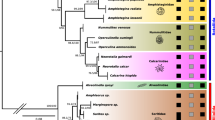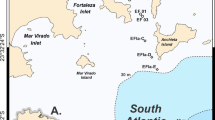Abstract
The diversity and distribution of modern benthic foraminifera has been extensively studied in order to aid the paleoecological interpretation of their fossil record. Traditionally, foraminiferal species are identified based on morphological characters of their organic, agglutinated or calcareous tests. Recently, however, new molecular techniques based on analysis of DNA sequences have been introduced to study the genetic variation in foraminifera. Although the number of species for which DNA sequence data exist is still very limited, it appears that morphology-based studies largely underestimated foraminiferal diversity. Here, we present two examples of the use of DNA sequences to examine the diversity of benthic foraminifera. The first case deals with molecular and morphological variations in the well-known and common calcareous genus Ammonia. The second case presents molecular diversity in the poorly documented group of monothalamous (single-chambered) foraminifera. Both examples perfectly illustrate high cryptic diversity revealed in almost all molecular studies. Molecular results also confirm that the majority of foraminiferal species have a restricted geographic distribution and that globally distributed species are rare. This is in opposition to the theory that biogeography has no impact on the diversity of small-sized eukaryotes. At least in the case of foraminifera, size does not seem to have a main impact on dispersal capacities. However, the factors responsible for the dispersal of foraminiferal species and the extension of their geographic ranges remain largely unknown.



Similar content being viewed by others
References
Alve E, Goldstein ST (2003) Propagule transport as a key method of dispersal in benthic foraminifera (Protista). Limnol Oceanogr 48:2163–2170
Boltovskoy E, Wright R (1976) Recent foraminifera. Junk Publ., The Hague
Bowser SS, Bernhard JM, Habura A et al (2002) Structure, taxonomy and ecology of Astrammina triangularis (Earland) an allogromiid-like foraminifer from Explorers Cove, Antarctica. J Foram Res 32:364–374
Chao A, Li PC, Agatha S et al (2006) A statistical approach to estimate soil ciliate diversity and distribution based on data from five continents. Oikos 114:479–493
Culver SJ, Buzas MA (1998) Patterns of occurrence of benthic foraminifera in time and space. In: Donovan SK, Paul CRC (eds) The adequacy of the fossil record. Cambridge Univ. Press, Cambridge, pp 207–226
Debenay JP, Pawlowski J, Decrouez D (1996) Les foraminifers actuels. Masson, Paris
Ellis BFS, Messina AR (1940) Catalogue of foraminifera. Am Nat Mus NY Spec Publ
Finlay BJ (1998) The global diversity of protozoa and other small species. Int J Parasitol 28:29–48
Finlay BJ, Esteban GF, Fenchel T (2004) Protist diversity is different? Protist 155:15–22
Finlay BJ, Esteban GF, Brown S et al (2006) Multiple cosmopolitan ecotypes within a microbial eukaryote morphospecies. Protist 157: 377–390
Flakowski J, Bolivar I, Fahrni J et al (2005) Actin phylogeny of foraminifera. J Foram Res 35:93–102
Foissner W (2006) Biogeography and dispersal of micro-organisms: a review emphasizing protists. Acta Protozool 45:111–136
Garcia-Cuetos L, Pochon X, Pawlowski J (2006) Molecular evidence for host-symbiont specificity in soritid foraminifera. Protist 156:399–412
Gooday AJ, Pawlowski J (2004) Conqueria laevis gen. and sp. nov., a new soft-walled, monothalamous foraminiferan genus from the deep Weddell Sea. J Mar Biol Assoc UK 84:919–924
Gooday AJ, Holzmann M, Guiard J et al (2004) A new monothalamous foraminiferan from 100–6300 m water depth in the Weddell Sea: morphological and molecular characterization. Deep-Sea Res 2:1603–1616
Habura A, Pawlowski J, Hanes SD et al (2004) Unexpected foraminiferal diversity revealed by small-subunit rRNA analysis of Antarctic sediment. J Eukaryot Microbiol 51:173–179
Haynes JR (1981) Foraminifera. Macmillan Publ., London
Haynes JR (1992) Supposed pronounced ecophenotypy in foraminifera. J Micropaleontol 11:59–63
Hayward BW, Hollis CS (1994) Brackish foraminifera in New Zealand; a taxonomic and ecological review. Micropaleontology 40:185–222
Hayward BW, Holzmann M, Grenfell HR et al (2004) Morphological distinction of molecular types in Ammonia—towards a taxonomic revision of the world’s most common and misidentified foraminiferal genus. Mar Micropaleontol 50:237–271
Holzmann M (2000) Species concept in foraminifera: Ammonia as a case study. Micropaleontology 46(Suppl 1):21–37
Holzmann M, Pawlowski J (1996) Preservation of foraminifera for DNA extraction and PCR amplification. J Foram Res 26:264–267
Holzmann M, Pawlowski J (1997) Molecular, morphological and ecological evidence for species recognition in Ammonia (Foraminifera, Protozoa). J Foram Res 27:311–318
Holzmann M, Pawlowski J (2000) Taxonomic relationships in the genus Ammonia (Foraminifera) based on ribosomal DNA sequences. J Micropaleontol 19:85–95
Holzmann M, Pawlowski J (2002) Freshwater foraminiferans from Lake Geneva: past and present. J Foram Res 32:344–350
Holzmann M, Piller W, Pawlowski J (1996) Sequence variations in large-subunit ribosomal RNA gene of Ammonia (Foraminifera, Protozoa) and their evolutionary implications. J Mol Evol 43:145–151
Holzmann M, Piller W, Fenner R et al (1998) Morphologic versus molecular variability in Ammonia spp. (Foraminifera, Protozoa) from the Lagoon of Venice, Italy. Rev Micropaleontol 41:59–69
Holzmann M, Habura A, Giles H et al (2003) Freshwater foraminiferans revealed by analysis of environmental DNA samples. J Eukaryot Microbiol 50:135–139
Mc Gann M, Sloan D (1996) Recent introduction of the Foraminifer Trochammina hadai Uchio in San Francisco Bay, California, USA. Mar Micropaleontol 28:1–3
Meisterfeld R, Holzmann M, Pawlowski J (2001) Morphological and molecular characterization of a new terrestrial allogromiid species: Edaphoallogromia australica gen. et spec. nov. (Foraminifera) from Northern Queensland (Australia). Protist 152:185–192
Murray JW (1991) Ecology and paleoecology of benthic Foraminifera. Longman, New York
Nehring S, Leuchs H (2000) Neozoen im Makrobenthos der Brackgewässer an der deutschen Nordseeküste. Lauterbornia 39:73–116
Nyholm KG (1974) New monothalamous foraminifera. Zoon 2:117–122
Pawlowski J (2000) Introduction to the molecular systematics of foraminifera. Micropaleontology 46(Suppl 1):1–12
Pawlowski J, Lee JJ (1992) The life cycle of Rotaliella elatiana n.sp.: a tiny macroalgavorous foraminifer from the Gulf of Elat. J Protozool 39:131–143
Pawlowski J, Holzmann M (2002) Molecular phylogeny of Foraminifera - a review. Eur J Protistol 38:1–10
Pawlowski J, Bolivar I, Fahrni J et al (1995) DNA analysis of Ammonia beccarii morphotypes: one or more species? Mar Micropaleontol 26:171–178
Pawlowski J, Fahrni J, Bowser SS (2002a) Phylogenetic analysis and genetic diversity of Notodendrodes hyalinosphaira. J Foram Res 32:173–176
Pawlowski J, Fahrni JF, Brykczynska U et al (2002b) Molecular data reveal high taxonomic diversity of allogromiid Foraminifera in Explorers Cove (McMurdo Sound, Antarctica). Polar Biol 25:96–105
Pawlowski J, Holzmann M, Berney C et al (2003) The evolution of early Foraminifera. Proc Nat Acad Sci 100:11494–11498
Pawlowski J, Fahrni JF, Guiard J et al (2005) Allogromiid Foraminifera and gromiids from under the Ross Ice Shelf: morphological and molecular diversity. Polar Biol 28:514–522
Pawlowski J, Fahrni J, Lecroq B, Longet D, Cornelius N, Excoffier L, Cedhagen T, Gooday AJ (2007) Bipolar gene flow in deep-sea foraminifera. Mol Ecol 16:4089-4096
Poag CW (1978) Paired foraminiferal ecophenotypes in Gulf Coast estuaries: ecological and paleoecological implications. Trans Gulf Coast Assoc Geol Soc 28:395–421
Sabbatini A, Pawlowski J, Gooday AJ et al (2004) Vellaria zucchellii n.sp., a new small monothalamous foraminifer from Terra Nova Bay, Antarctica. Antarct Sci 16:307–312
Schnitker D (1974) Ecophenotypic variation in Ammonia beccarii (Linné). J Foram Res 4:216–223
Schweizer M, Pawlowski J, Duijnstee IAP et al (2005) Molecular phylogeny of the foraminiferan genus Uvigerina based on ribosomal DNA sequences. Mar Micropaleontol 57:51–67
Slapeta J, Lopez-Garcia P, Moreira D (2006) Global dispersal and ancient cryptic species in the smallest marine eukaryotes. Mol Biol Evol 23:23–29
Thalmann HE (1952) Twenty years of “foraminiferal statistics”: 1931 to 1950. Cushman Found Foram Res Contr 3–4:145–146
Tsuchiya M, Kitazato H, Pawlowski J (2000) Phylogenetic relationships among species of Glabratellidae (Foraminifera) inferred from ribosomal DNA sequences: comparison with morphological and reproductive data. Micropaleontology 46(Suppl 1):13–20
Tsuchiya M, Kitazato H, Pawlowski J (2003) Analysis of internal transcribed spacer of ribosomal DNA reveals cryptic speciation in Planoglabratella opercularis. J Foram Res 33:285–293
Walton WR, Sloan BJ (1990) The genus Ammonia Brünnich, 1772: its geographic distribution and morphologic variability. J Foram Res 20:128–156
Acknowledgements
The authors thank T. Cedhagen, W. Majewski, S. Bowser, A. Habura and S. Korsun for stimulating discussion and help in collecting the material, and A. Gooday for comments on the manuscript. We also thank J. Fahrni, J. Guiard, D. Longet and J. S. Pawlowski for assistance. The work was supported by the Swiss NSF project 3100A0-112645 (JP) and the Austrian FWF project T270-B03 (MH).
Author information
Authors and Affiliations
Corresponding author
Additional information
Special Issue: Protist diversity and geographic distribution. Guest editor: W. Foissner.
Rights and permissions
About this article
Cite this article
Pawlowski, J., Holzmann, M. Diversity and geographic distribution of benthic foraminifera: a molecular perspective. Biodivers Conserv 17, 317–328 (2008). https://doi.org/10.1007/s10531-007-9253-8
Received:
Accepted:
Published:
Issue Date:
DOI: https://doi.org/10.1007/s10531-007-9253-8




